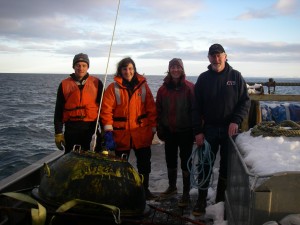
In early January, a wave buoy operated by the Alaska Ocean Observing System in Cook Inlet broke free from its mooring for the third time in less than two years. The inlet has 30-foot tides and strong tidal currents, so immediate action was necessary to rescue the floating device before it escaped into the Pacific Ocean.
The Director of the National Centers for Coastal Ocean Science’s Kasitsna Bay Laboratory led the rescue effort with support from staff at the Kachemak Bay National Estuarine Research Reserve,the U.S. Fish and Wildlife Service, Homer harbormaster, and local fishermen. Using a fishing vessel, NOAA tide and current information and satellite-transmitted locations, the team was able to pick up the 400-lb buoy less than a day after it broke loose. They hauled it back to a nearby warehouse to keep it sheltered from the instrument-freezing elements.
When it’s not trying to escape, the buoy (now nicknamed “Bandit”) transmits the only real-time information about wave height and direction in Cook Inlet to many users, including NOAA weather forecasters, fishermen, boaters and even—how is this possible?—surfers.
